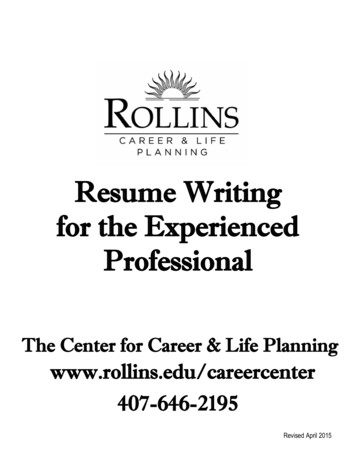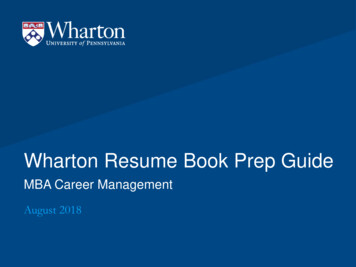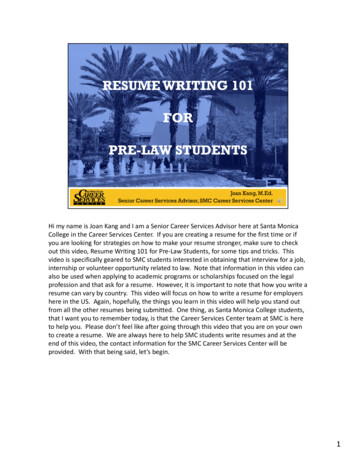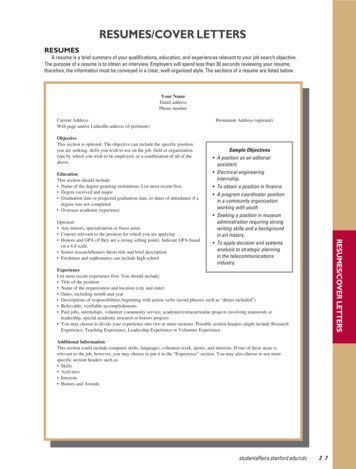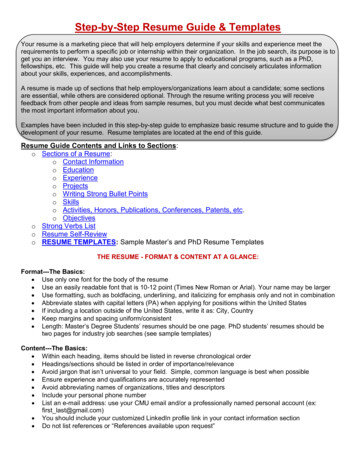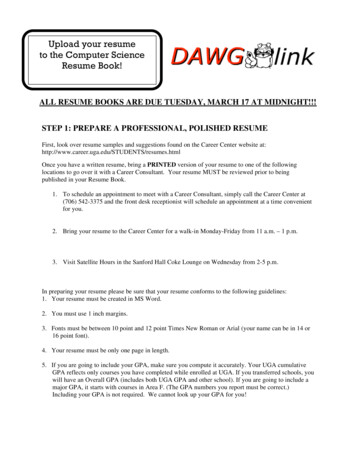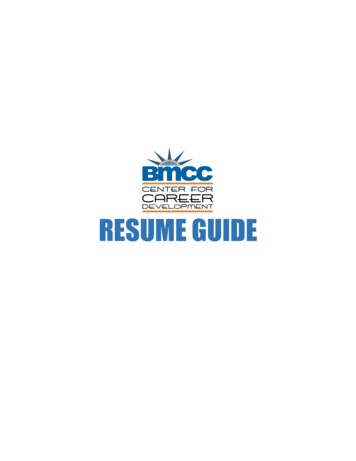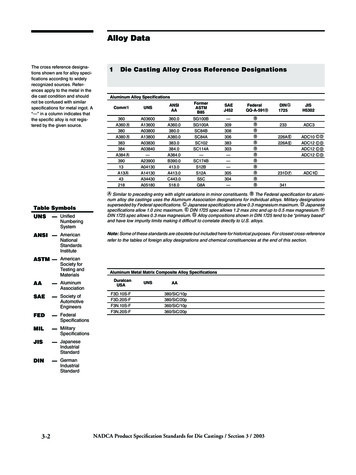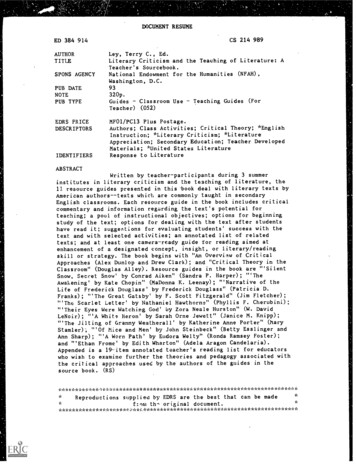
Transcription
DOCUMENT RESUMECS 214 989ED 384 914AUTHORTITLESPONS AGENCYLey, Terry C., Ed.Literary Criticism and the Teaching of Literature: ATeacher's Sourcebook.National Endowment for the Humanities (NFAH).Washington, D.C.PUB DATENOTEPUB TYPE93320p.EDRS PRICEDESCRIPTORSMF01/PC13 Plus Postage.Authors; Class Activities; Critical Theory; *EnglishInstruction; *Literary Criticism; *LiteratureAppreciation; Secondary Education; Teacher DevelopedMaterials; *United States LiteratureResponse to LiteratureIDENTIFIERSClassroom UseGuidesTeacher) (052)Teaching Guides (ForABSTRACTWritten by teacher-participants during 3 summerinstitutes in literary criticism and the teaching of literature, the11 resource guides presented in this took deal with literary texts byAmerican authors--texts which are commonly taught in secondaryEnglish classrooms. Each resource guide in the book includes criticalcommentary and information regarding the text's potential forteaching; a pool of instructional objectives; options for beginningstudy of the text; options for dealing with the text after studentshave read it; suggestions for evaluating students' success with thetext and with selected activities; an annotated list of relatedtexts; and at least one camera-rcady guide for reading aimed atenhancement of a designated concept, insight, or literary/readingskill or strategy. The book begins with "An Overview of CriticalApproaches (Alex Dunlop and Drew Clark); and "Critical Theory in theClassroom" (Douglas Alley). Resource guides in the book are "'SilentSnow, Secret Snow' by Conrad Aiken" (Sandra P. Harper); "'TheAwakening' by Kate Chopin" (MaDonna K. Leenay); "'Narrative of theLife of Frederick Douglass' by Frederick Douglass" (Patricia D.Franks); "'The Great Gatsby' by F. Scott Fitzgerald" (Jim Fletcher);"'The Scarlet Letter' by Nathaniel Hawthorne" (Phyllis F. Cherubini);"'Their Eyes Were Watching God' by Zora Neale Hurston" (W. DavidLeNoir); "'A White Heron' by Sarah Orne Jewett" (Janice M. Knipp);"'The Jilting of Granny Weatherall' by Katherine Anne Porter" (MaryStamler); "'Of Mice and Men' by John Steinbeck" (Betty Esslinger andAnn Sharp); "'A Worn Path' by Eudora Welty" (Ronda Ramsey Foster);and "'Ethan Frome' by Edith Wharton" (Adela Aragon Candelaria).Appended is a 19-item annotated teacher's reading list for educatorswho wish to examine further the theories and pedagogy associated withthe critical approaches used by the authors of the guides in thesource book. *************************Reproductions supplied by EDRS are the best that can be made*ftem th-, original *******************************
Literary Criticism and theTeaching of LiteratureA Teacher's SourcebookEdited byTerry C. LeyCurri-ulum and Teaching5040 Haley CenterAuburn University, AL 36849U S DEPARTMENT OF EDUCATIONoil., e Ot EnucnlonaI Fivsonfen end impv.EDUCATIONAL RESOURCES INFORMATIONCENTER (ERIC)"PERMISSION TO REPRODUCE THISMATERIAL HAS BEEN GRANTED BYhis document has been reproduced asreceived am the person or organizationoriginating itMinor changes have been made toimprove reproduction quality1993TO THE EDUCATIONAL RESOURCESINFORMATION CENTER (ERICIBEST COPY AVAILABLE2Points of view or opinions stated in thisdocument do not necessarily reoreserstofficial OERI position or policy
ContentsForeword3An Overview of Critical Approaches7Alex Dunlop and Drew Clark21Critical Theory in the ClassroomDouglas Alley"Silent Snow, Secret Snow" by Conrad Aiken27Sandra P. Harper71The Awakening by Kate ChcpinMa Donna K. LeenayNarrative of the Life of Frederick Douglass99by Frederick DouglassPatricia D. Franks127The Great Gatsby by F. Scott FitzgeraldJim FletcherThe Scarlet Letter by Nathaniel Hawthorne154Phyllis F. CherubiniTheir Eyes Were Watching God by Zora Neale Hurston190W. David Le Noir"A White Heron" by Sarah Orne JewettJanice M. Knipp1215
"The Jilting of Granny Weatherall" by Katherine Anne Porter230Mary Stamler251Of Mice and Men by John SteinbeckBetty Esslinger and Ann Sharp"A Worn Path" by Eudora Welty283Ronda Ramsey FosterEthan Frorne by Edith Wharton303Adela Aragon Candelaria340A Teacher's Reading ListW. David LeNoir24
ForewordThe resource guides which appear in this volume were written byteacher-participants during three summer institutes in literary criticism and theteaching of literature, five-week institutes conducted on the campus of AuburnUniversity in 1985, 1987, and 1988. Funded by grants from the NationalEndowment for the Humanities and the university, the institutes weredesigned to provide opportunities for secondary school English teachers toexpand their knowledge of literary criticism and their.abilities to apply thatknowledge to instructional planning based upon sound teaching principles.One hundred twenty-four teachers from 31 states and Guam participated inthe institutes.Although more than half of the participants had earned master'sdegrees in either English or English Education, few had had any formalinstruction in literary criticism. Their early responses to literaturethelanguage that they used during discussions or in their journal entries, thequestions that they askedreflected the strong influence of New Criticism ontheir preparation as English teachers. Throughout the institutes, participantsdevoted half of their time to attending lectures and participating in discussionsrelated to selected critical approaches and assigned literary texts, all of whichare frequently taught in secondary schools. Eminent scholars of literarycriticism who served as guest lecturers during this portior. of the institutes
included Robert Denham, Judith Fetter ley, Marjorie Garber, W. J. T. Mitchell,Mary Poovey, Robert Probst, Peter Rabinowitz, and Louise Rosenblatt.During the other half of each institute, participants considered readingtheory and its applications to the teaching of literature, developed teachingstrategies for literary texts that they had studied together, and developed 85resource guides, all of which appear in the sourcebooks published by theuniversity following each institute.Participants were permitted to cho.,se the literary texts for which theydeveloped resource guides so long as the texts were frequently taught insecondary schools. Some chose to develop materials for texts consideredduring an institute, but most chose others with which they were familiar.They were also given the opportunity to organize development teams if theywished.Individuals or teams were asked to develop resource guides containingthe following information for themselves and prospective readers:An overview which includes a critical commentary and informationregarding the text's potential for teachingA pool of instructional objectives from which teachers might selectthose which are appropriate for their classesOptions for boginning study of the text, including activities which buildbackground (including concepts and vocabulary), provide a preview,and establish purposes for reading
5Options for dealing with the text after students have read it, includingdiscussion and activities requiring oral and written communicationSuggestions for evaluating students' success with the text and withselected activitiesAn annotated list of related textsAt least one camera-ready guide for reading aimed at enhancement of adesignated concept, insight, or literary/reading skill or strategy.The eleven resource guides selected for this volume are for literary textsby American authors--an arbitrary decision made by an editor blessed with toomuch fine material to publish in one volume. Some of the texts are classics,some are modern; some are short stories, some are novels, and one is anautobiographical narrative; some were written by men, some by women; andsome were written by minority authors. Teacher-authors selected criticalapproaches that they thought were appropriate for interpreting their respectivetexts. All of the critical approaches which the institutes emphasized areprominent in the critical commentaries, instructional objectives, and activitiesfor at least three of the resource guides: New Criticism, neo-Aristotelian,archetypal, psychoanalytic (or psychological), reader response, and feminist.The guides are intended as resources, not lesson plans; indeed, teachers willneed to be selective and creative in their use of the guides, for they contain agreat deal more than teachers will have time to use.
6Several institute staff members have shared with me the responsibilityfor preparing this publication. Three outstanding Alabama EnglishteachersCliff Browning, Sara McAnulty, and Loyd Mehaffeyserved theinstitutes as mentor-teachers. In addition to their teaching duties, they advisedparticipants while they were developing their resource guides and, later,evaluated the guides and helped to prepare them for institute publications.Douglas Alley, a professor of English Education at Auburn University anddirector of the institutes, helped to edit all three institute publications. Finally,I am greatly indebted to David Le Noir, an institute participant in 1985 andcurrently an instructor in English Education at Auburn. His skilled and criticalreading, his attention to detail, his sound advice, and his industry havecontributed a great deal to this professional enterprise.Terry C. LeyAuburn UniversityJune 1993
An Overview of Critical ApproachesAlex DunlopDrew ClarkDepartment of EnglishAuburn UniversityAt Auburn's three NEH Institutes for the study of literary criticism,high school teachers examined a number of critical theories and concepts,among them New Criticism, Aristotelian criticism, reader response criticism,Freudian, Jungian, Marxist, and archetypal criticism, feminism, structuralism,deconstruction and new historicism. Emphases shifted from Institute toInstitute in accord with the interests of the guest speakers, the professors, andthe teachers. The analyses contained in this volume represent many of thoseinterests. The iteration of labels of the various theories and concepts maysuggest the possibility of mixing bits of this and that to make an approach toour particular taste. However, approaches to literature reflect approaches tolife, and each of the approaches we have identified represents a set of beliefsconcerning the nature of language and its functions in our lives. Each has itsown contexts: a history, social and political implications, and relationshipswith other approaches to literature. Our intention in this introduction is to notebriefly some of those contexts.7
Literary criticism in America from 1930 to 1970 was concernedpreeminently with form. Of the formalistic movements, none has been moreinfluential than New Criticism, of which the professed program was simplythe careful reading of the literary text as an integral unit. That it is hard toimagine what can have been so new about such a program indicates the extentto which New Criticism has revolutionized critical practice. In fact, the idea ofnewness was essential to New Criticism, which, in reaction against anineteenth-century historicism emphasizing the biographies of authors and asubjective aestheticism based on the intuitive judgment of educated readers,defined itself in large part by what it was not.First and foremost, it was not the study of authors. Though concedingthat books may tell us a great deal about their authors, New Critics sharplydistinguished the value of such information from the moral, intellectual, oremotional value of the work itself. This specifically literary value is expressedin the words that make up the text and that, once published, exist independentof the wishes or of the subsequently expressed opinions of the author. TheNew Critics labelled any failure to recognize the independence of the text fromits author the "intentional fallacy." Similarly, New Criticism was not the studyof readers. The reader, New Critics insisted, is no more a part of the text thannatural scientists are part of the materials they study. New Critics felt thatmeaning must reside in the text, for without a text independent of the8
subjective biases of the reader, criticism would become groundless subjectivity,a threat that seemed increasingly unattractive during the years when criticismwas establishing itself ever more firmly as a discipline in universitiesdominated, like the time generally, by the glamor and power of natural scienceand technology. To accord undue attention to the variable responses of readerscame to be called the "affective fallacy." In the same way, though literaturemay be political, religious, philosophical, psychological, or sociological, NewCriticism was not the study of any of those disciplines. The assumption thatthere is something specifically literary about some uses of language served toset literature apart and to focus critical attention of the work's literariness (aterm developed by the Russian Formalists early in the twentieth century) or onwhat New Critics often called poetry as poetry (and not some other thing).Approaches to literature from the perspective of any other discipline werelabelled "extrinsic."The New Critics, to whom the ontological independence of the textseemed self-evident, did not theorize much about literariness. Their businesswas to produce readings, to put the text under the literary microscope in aprocess of analysis called "close reading" in order to determine precisely whatits parts are and how they relate to the whole. Characteristically, the NewCritics understood this whole as a pattern of words, images, and symbolsreconciling or balancing tensions and, paradoxes in an organic unity of9it
meaning. This principle provided also the basis for evaluation, which wasfundamental to their enterprise; the greater and more vexing the complexityincorporated into its organic unity, the greater the work. Hence followed thepoetic practice of T. S. Eliot, whose,creative and critical writings were essentialNew Critical documents, and the admiration of the New Critics for the Englishmetaphysical poets.By mid-century New Criticism had the field largely to itself. But notentirely. A small but vocal group of scholars at the University of Chicagoemphasized the old rather than the new as they championed Aristotelianprinciples and methods for the interpretation of literature. Because ofAristotle's emphasis on the preliminary identification of species in order torecognize the qualities peculiar to each, the neo-Aristotelian literary criticascribed more importance than the New Critic to literary genres or types.mother difference between these critical groups was the neo-Aristotelians'"pluralistic" willingness to admit social or political aspects of a work as part.albeit a secondary part, of its overall aesthetic effect. Most important, the twogroups differed in what they emphasized as the basic stuff and the immediatepurpose of literature. Where the N'w Critic saw primarily words and imagesarranged to produce a meaning, the neo-Aristotelian saw primarily animitation of human action and experience arranged to produce an emotionaleffect.1012
Today the differences of these mid-century schools of criticism seemless important than their similarities. The most lasting contributions of bothNew Critics and neo-Aristotelians may be, first, their insistence on attention tothe concrete, the particular, and the specific, and, second, their emphasis onmethodological consistency and self-awareness. The most problematiccharacteristic of both groups, however, was their preoccupation with thecoherence of the literary text. Virtually all subsequent critical theory haschallenged or redefined the notion of the text as an independent whole.One such redefinition involved the recognition that the literary workcomes fully into being neither when it is conceived nor when it is printed, butonly when it is read. To understand literature, then, we must study the readerand the process of reading. Drawing on European antecedents, reader responsecriticism became influential in America in the decade of the seventies. Readerresponse critics differ in locating the ti zcurrence of the work closer to the textor closer to the reader. For Wolfgang Iser the process in dialectical: the reader"actualizes" the potential of the text, but the text at the same time "occupies"and "supplants" the thoughts of the reader. On the other hand, Stanley Fishemphasizes the role of the reader: "interpreters do not decode poems: theymake them" (327). Such a principle undermines formalist assumptions ofliterariness, for if the reader makes the poem, anything can be a poem, even,as Fish argues, a simple list. To avoid radical subjectivity, Fish reaches not11
back towards the text, as had the New Critics, but outward to society: wedistinguish acceptable readings from idiosyncratic ones by "the authority ofinterpretive communities." In practice reader response criticism focuses withvarying degrees of closeness on the experience of the reader readingonpatterns of anticipation and retrospection, on assurptions and conditions. Thelegacy of the flourishing of reader response theory in the seventies has beenfar-reaching and multi-faceted: a number of active scholars who identifythemselves as reader response critics, a broad interest in subsequent theoryand criticism in the role of the reader, and a modification of pedagogicalpractice at all levels.Other approaches of the last thirty years have continued the centrifugalmovement away from the independent, integral text as the central object ofcritical attention. These approaches vary widely and have proliferated rapidly.They include linguistically-based structuralism and its inheritors,psychoanalytic and archetypal criticism, and various forms of historical andpolitical analysis, notably including feminism. Rejecting the idea of literature-as-literature as a disabling tautology, these scholars and teachers havevariously investigated how reading and writing work in, among, and upon ourlanguages, our psyches, and our social groups. To them, literary texts recordand often occasion significant and signifying behavior. Literature, in otherwords, does not insulate writers and readers from the conflicting currents of1214
their hisfrirical moment, their culture, their families, or their own minds. Itrather may reveal, under analysis, the meaning of behavior, especially of thatsort of behaving we do with texts.Two of these approaches are related: psychoanalytic criticism and itssometimes prodigal offspring, archetypal criticism. The first approach derives,of course, from the theories and writings of Sigmund Freud, though now mostpsychoanalytic criticism has been much influenced by post-Freudian writerssuch as tl-e French analyst Jacques Lacan. The archetypal approach derivesfrom the ideas of Freud's one-time associate, Carl Jung, who quarrelledfamously with his teacher over some issues. In these two approachesunderstanding literature is a special case of understanding psychology. Likeour myths and dreams (and like our symptoms, slips of the tongue, and freeassociations), literature represents strategies for dealing with commonrecurrent psychological problems. Also like other, non-literary strategies,literature often represents these problems and strategies in cryptic form,requiring decoding. Because psychoanalytic and archetypal critics hold thatliterature symbolically represents responses to unconscious problems, thewhole dynamic remains veiled until analysis uncovers its secret operations.Moreover, both psychoanalytic and archetypal studies often attempt to showhow psychological mechanisms shape the behavior not only of literarycharacters but also of writers and readers.13
To psychological critics tile differences between the psychoanalytic andarchetypal approaches are likely to matter more than their similarities. Briefly,we might suggest, the Jungian paradigm is heroic, the Freudian ironic.Jungians tend to emphasize how the hero's psyche takes form, by a processJung called "individuation"; even within heroic legends, on the other hand,Freudians find cross-cutting desires and defenses that, both inside and outsideof texts, deform human beings even as they are formed. Usually, the Jungianapproach has at hand more devices and symbols, seen as primitive elements ofpsychic structure stored in the "collective unconscious": the animus and anima,shadow-selves, wise old men, great mothers, and Peter Pans, not to mentionthe alchemical charts, mandalas, and flying saucers with which Jung was alsomuch concerned. Freudian analysis of texts is no less rich, but it usually workswith fewer symbols. Freud, too, was an archetypal thinker, but he revertedconstantly to a few situations and conflicts: the Oedipus complex, for example-its formation, its repression, its reassertion in the formation of symptoms, andits undoing in sublimation or the so-called transference. Today Freud'sauthority seems much better established among literary critics than Jung's. Aslong as we perceive that stories, poems, plays, and movies are about what wehave called our minds, souls, spirits, or selves, psychoanalytic and archetypalcriticism will remain attractive to many.1416
Another approach to literature sometimes linked with Jungianarchetypalism is represented in the writing of the Canadian theorist NorthropFrye, especially his famous Anatomy of Criticism (1957). Like the New Criticsand the neo-Aristotelians, Frye treats literature as an autonomous realm. Hediffers from these formalist critics, however, in proposing that all of literature-the order of wordscan be treated as a body of unified phenomena, a "world"whose workings can be studied and explained almost scientifically by literarycriticism, just as the workings of the material world are treated by the naturalsciences. Because of this assumption, Frye rejects evaluation as a part ofliterary study. The object of studying literature is not to show why some worksare better than others (a common feature of New Criticism) but to understand,dispassionately, how the literary system functions. Influenced by studies ofcomparative religion, Frye has proposed a structure of literary "mythology,"according to which all individual works can be understood as retellings, invarious modes, of the seasonal pattern of growth, fructification, decay, andrenewal.Two very important movements in literary criticism since 1960,structuralism and deconstruction, are not represented in these teaching guidesbut should be mentioned here. Their absence from these exemplary pedagogiesresults partly from the nature of their governing assumptions. Structuralismabroad movement across many disciplines in the humanities and social15
scienceswas an attempt to uncover the basic rules and permutations of signsystems, whether those appear in fairy tales, in grammar, or in kinship terms.The French critic Roland Barthes produced basically structuralist studies ofwrestling, striptease, and fashion. In literary study, structuralism usually aimsnot to interpret single works but to examine and clarify the rules of readingwithin a given community that make intelligible interpretations possible tobegin with. Deconstruction, which is sometimes linked with other approachesof the 1970's and 1980's under the general heading "post-structuralism," growsout of certain ideas in structuralist linguistics and skeptical epistemology. It isgenuinely post-structuralist, because deconstructionists consider intelligibilityitself as a problem, not a given, of reading. Deconstructive activity hasproduced a wide range of interesting work, from critical accounts of Westernmetaphysics like Jacques Derrida's Of Grammatology to brief, skeptical"readings" of Donne's "The Canonization" or Melville's Billy Budd, readingswhich seem uncannily like New Criticism stood on its head.Another set of approaches to literature, strongly represented in workdone since 1960, begins from analysis of social groups or classes rather than ofindividual psyches. These approaches include Marxist and feminist ways oftalking about literature. Both of these critical movements are explicitly devotedto bringing about certain social changes. Both usually claim, also, that so-callednon-political approaches to literary study have a concealed politics, usually a16
conservative one. The social approach itself includes less obviously politicizedmovementsfor example, various forms of reader response theory and what istoday called cultural studies, including the new historicism and the study ofliterary institutions. Despite their many differences, most of these approachesderive their basic assumptions about literature from theories of history. Alongwith the insistence on the importance of historical context there often comes acommitment to particular values, whether traditional or innovative, and toprograms of action, whether conservative or revisionary. Suspicious ofuniversalizing claims about "human nature," "archetypes," or, for that matter,"literature," critics and teachers using this approach argue that the texts wecall literature cannot reasonably be separated from the material and socialconditions in which they were first produced or in which they are read anddiscussed today. More than that, such people argue that those who write andread and study literary texts use them to affect relations of power that help toform those conditions.Certainly one of the most vital of these social approaches to readingand writing is feminist literary criticism. Feminist critics and teachers haveundertaken two basic tasks: to resist the dominant, male-centered literarysystem and to discover alternatives to it. Already the work at the second ofthese tasks has produced impressive results. Many "lost" books written bywomen have been found, edited, and published in inexpensive editions. The17
standard college anthologies of literature now include more works by womenthan they once did, and whole anthologies of women's writing are now beingmarketed. In short, the old canon of received texts has been substantiallyreshaped. But feminist critics have also altered our understanding of texts weonce thought we knew, just as feminism more generally has altered who getsaccess to education and hence to "understanding texts" to start with. Feministcritics have asked unsettling questions about many traditionally valued texts.What does The Taming of the Shrew or For Whom the Bell Tolls have to say aboutwomen? When schoolgirls read books about men and boys, especially booksthat represent misogyny in one form or another (say, Rip Van Winkle orHuckleberry Finn), what happens, especially if they are taught that these booksalso represent "the" American experience? Just as the bibliographic work offeminist criticism has unearthed buried texts by women, so its interpretivework has made possible new responses to familiar texts by men and womenalike.There have been many areas of disagreement among feminists. Forexample, do women's text constitute a different order of writing altogether,what some French feminists call ecriture feminine? Or is it simply that somewomen have written texts that, although they have been unjustly neglected, donot upset previous canons of taste? Is gender a privileged category forunderstanding reading and writing? What about other markers that may affect18
how a woman reads and is readher race, her class, her general education,her religious creed? In its first phase, feminist criticism privileged the conceptof gender. Now, generally speaking, other questions have gained new urgency,enabled largely by the accomplishments of first-stage feminist study. Thisdiversity of accents within feminist criticism reflects the whole spectrum ofcontemporary ways of reading literature. It has become a necessary andexciting fact of most critical experience today, both in the university and in thehigh school.ReferencesFish, Stanley. Is There a Text in This Class?: The Authority of InterpretiveCommunities. Cambridge, MA: Harvard UP, 1980.194
Critical Theory in the ClassroomDouglas AlleyDepartment of Curriculum and TeachingAuburn UniversityThe reading cf literature is an autonomous activity between the readerand the text. Readers bring to bear upon their reading their total schema, theirknowledge, attitudes, ideas, and even their morality. Yet, as every teacherknows, a student can "read" every word of a text from start to finish and havelittle or nothing of importance to say about the experience. Hence, the truenature of literature requires the teacher to bring the experience of literaturefrom this private reading perspective to a communal discussion of ideas,responses, questions, and even disagreements. Literature then becomes ashared experience, an active enterprise that allows students to view literatureas a complex reflection of life, while at the same time allowing students toquestion their own motives, opinions, impressions, and concepts of whatliterature really is.Teachers of literature naturally approach a work of literature in manyways. However, the dialectic of the classroom, regardless of its form, isstrongly structured by the way teachers themselves extract meaning from theshort story, poem, novel, or drama being considered. Ms. Green, for example,is an eleventh grade teacher of literature who believes that only the text is2122
important, that if it is a good work of literature, all that is necessary for a"correct" analysis or interpretation is the language of the work itself. Theauthor's life, his intentions, and his effect should have little or no bearing onthe reader's understanding of the work. The language, the ambiguities, and thenuances are the important elements to be considered. She believes that formand meaning are inseparable, and she tries desperately to have her studentsrealize that an adequate analysis of the work must come from anunderstanding of h.
DOCUMENT RESUME. ED 384 914 CS 214 989. AUTHOR Ley, Terry C., Ed. TITLE Literary Criticism and the Teaching of Literature: A. Teacher's Sourcebook. S



